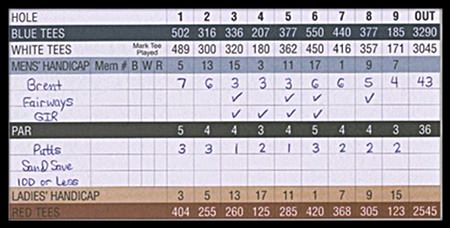“Guaranteed to take strokes off your game;” a claim made countless times by all manner of adverts featuring golf’s latest quick-fix, and designed with just you in mind. Yeah right. Well, here’s one more, but wait for it… this one’s for free, yes it won’t cost you a single satang. Ready for this? Simply put, start keeping your own stats.
Whether your handicap is three or thirty, recording certain statistics will, if done properly, lead to lower scores. Done properly, it should signal which part of your game offers the greatest scope for improvement, relative to your physical ability. Done properly, this exercise will show why certain courses test you in ways other don’t. Interested? Read on.
Firstly, this is about us amateurs, not pros. We have handicaps, they don’t. We don’t know how many GIRs or putts-per-round our competitors had, they do. We don’t have fitness trailers parked next to the practise fairway, they do. We (most of us) put slightly more importance on life off the course than on, they don’t. So, while we may want better scores, we don’t want to sacrifice an arm, a leg, or too many beers getting them. What we want to do is take strokes off our game working with what we’ve got. This means no new workout regime at the gym, nor a new-age diet, a swing change, a new set of clubs or a promise to refrain from drinking the night prior. And no lessons – well, maybe not yet.
 Keeping stats on your scorecard can help improve your game and shave shots off your score.
Keeping stats on your scorecard can help improve your game and shave shots off your score.
The claim that your game will improve by recording your own stats is based on a well-accepted axiom; one that states performance will likely improve simply through increased focus. Yes, fine, but focus on what?
Focus on just four stats; driving, greens in regulation, scrambling and putting.
1. Driving: Hitting more fairways is good, sure, but so too is length, even if it does finish off the short stuff. But a critical aspect of driving is staying out of trouble – OB and water-type trouble particularly. Think positively. Take driver and accept you will make mistakes, but not of the type where the cost is too penal. Play your natural shot shape away from trouble, even if that means finishing in rough. Record, in percentage terms, the number of fairways hit.
Driving Target – Amateur Averages (US) with distance in brackets: Scratch = 64% (286), 10-handicapper = 50% (225), 20-handicapper = 43% (190), 30 handicapper = 39% (175).
Note: most golfers, when asked how far they drive a golf ball, will overestimate by 20-40 yards. These yardages are not estimates.
2. Greens in Regulation (GIR): Percentage of greens hit in two shots less than par, or better. When playing par-3s you have an exact yardage, and are more likely to adjust for wind and elevation. Get the same information on all your approach shots, and make adjustments accordingly. Knowing how far you hit each club helps, as does knowing where to aim as it rarely is the flag. Unless you’re a scratch player, and the flag location suits your shot shape, aim for the middle of the green. Clever golfers will err on the side away from trouble.
GIR Target – Amateur Averages (US): Scratch = 61%, 10-handicapper = 39%, 20-handicapper = 22%, 30-handicapper = 12%.
3. Scrambling: saving par after missing the green. This category includes chipping, pitching from up to 30-yards out, and bunker play. Results expressed in percentages.
One key to lower scores is to become good to very good in the straightforward chipshot, which isn’t overly difficult even for the high-handicapper. Having done this you should try to give yourself more of those types of shot when you miss the green. In short, play to your levels of comfort.
Scrambling Target – Amateur Averages (US): Scratch = 52%, 10-handicapper = 32%, 20-handicapper = 21%, 30-handicapper = 13%.
4. Putting: Putts per round. To start, we will just focus on avoiding or reducing three-putts.
The first thing to get into your head is that good putters are more concerned with distance than direction. Second, unlike driving distance, there is no physical reason why we can’t putt as well as the pros. So get on the net and look up drills for distance control and practise same. Third, know where to leave your lag putt, which is never a breaking downhiller. Rather, give yourself a flat or uphill putt to finish, and always watch your ball as it goes by the hole.
Three-putt Prevention Target – Averages (per cent time three-putting): PGA Tour average = 3.2%, Scratch = 4%, 10-handicapper = 7%, 20-handicapper = 12%, 30-handicapper = 21%.
There are the four key stats complete with targets. Next week – beating those targets.
Happy golfing,
Golfnutter




